Wicker Patio Table Glass Top Wicker Patio Table Glass Top Art Van

What is the all-time material for outdoor furniture?
When evaluating outdoor furniture, you're probably going to wait for many of the same characteristics that you value in indoor tables, chairs and sofas – durability, comfort and style (and of course price). The primary deviation, nonetheless, is that patio piece of furniture has to endure exposure to the weather exterior. While in that location is virtually no 100% weatherproof patio piece of furniture, there are big differences based on the materials used.
Before you make up one's mind, it'southward important to understand the strengths and weaknesses of diverse material options. Decide how well each aligns with the requirements of your residential or commercial surroundings, every bit well as your personal preferences and priorities. Choosing the "best" material for outdoor patio article of furniture is dependent on matching your specific needs with the inherent qualities of each substance since each situation is unique.
Factors to Consider for Outdoor Materials
Outdoor furniture frames, tabletops and upholstery demand to retain structural integrity and their appearance over many seasons, and through a variety of weather condition conditions. Additionally, the time and effort needed to maintain materials throughout the year, also every bit their "green-ness" and costs are of import aspects to examine.
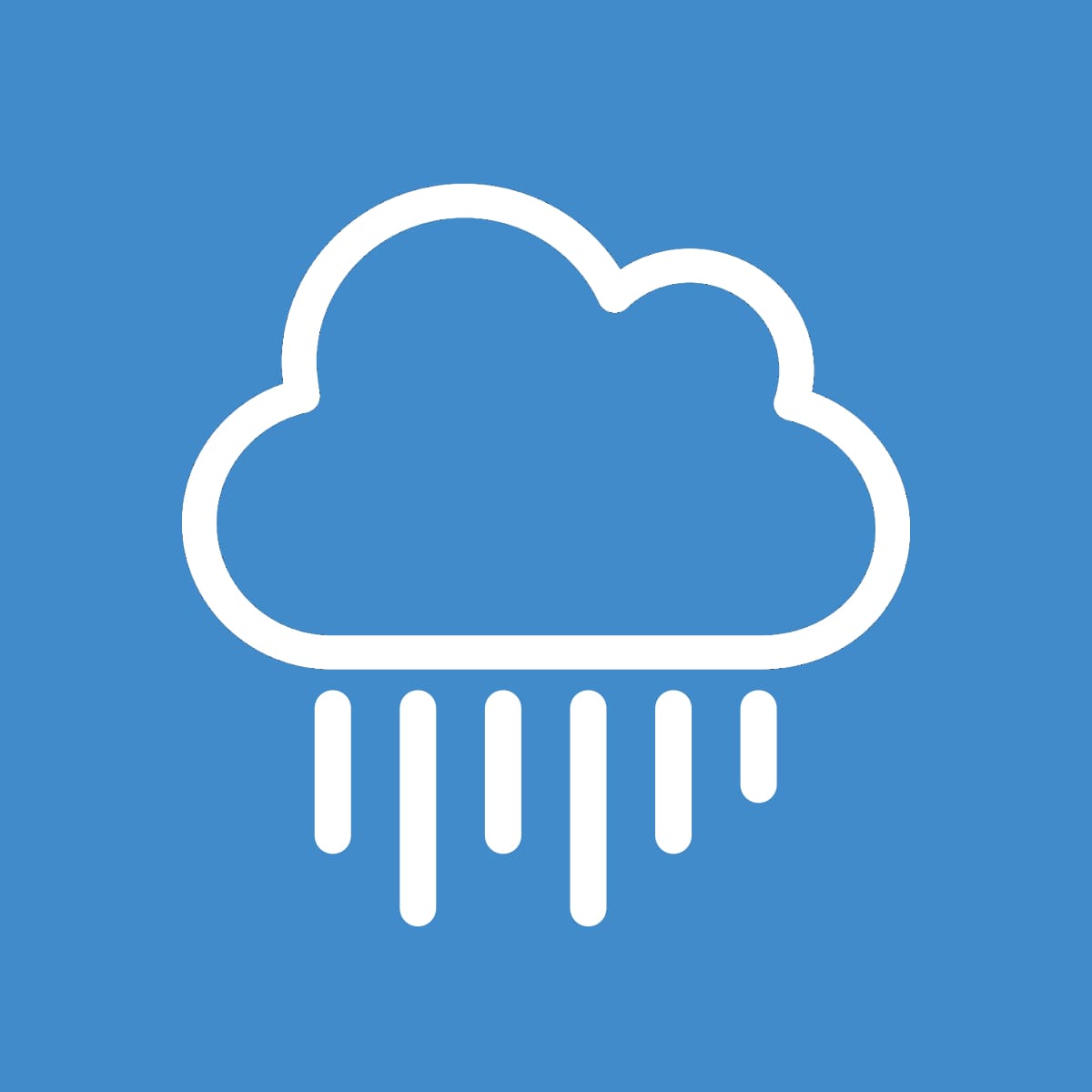
Rain & Moisture
If you lot live in an surface area where in that location are frequent rainstorms, or that has high humidity, yous want to exist sure that your piece of furniture is resistant to damage from various water-based issues. Standing water or retained moisture tin can not only physically dethrone the material, merely it tin likewise lead to health risks.
Mold, Mildew & Rot
Humid or moist atmospheric condition create an environment where diverse fungi thrive. Organic materials that retain water are susceptible to mold and mildew, which can cause respiratory bug, irritation and other health issues. However, they typically don't damage the cloth and tin be cleaned off. Rot, on the other hand, leads to biodegradation and decomposition (disuse) of the material.
Rust & Corrosion
Metals that contain iron or steel are vulnerable to corrosion when they are continually exposed to water and oxygen. The corrosive oxidation process slowly weakens these metals, resulting in visible rust and other discoloration. Salt in the air and water accelerates the chemical process, so rusting is often more prevalent in coastal regions.
Warping
Materials that allow h2o penetration can dry unevenly, resulting in warping (twisting or bowing) of the original shape. Initially, information technology may be imperceptible, but over fourth dimension information technology can noticeably distort the cloth, misalign seams and loosen screws and other fasteners used to hold the furniture together.

Lord's day & Temperature
If you lot live in a sunny surface area or one with dramatic seasonal climate shifts, you'll need to look for outdoor materials that tin withstand harm from harsh UV rays and fluctuations from extreme heat to cold.
Fading
Abiding exposure to the sun can cause many materials to fade and lose their luster over fourth dimension. The aesthetic change can be highly-seasoned (due east.thou. patina) or simply a decreased vibrancy of color or uneven spotting.
Cracking
Some materials noticeably expand and contract when they are heated or cooled. They can crack, split, warp or become brittle when exposed to extreme temperatures or drastic fluctuations. Dry air can besides cause furniture to bend and crack.
Rut Retention
The heat can besides lead to other logistical problems. Patio furniture that is left out in the sun can heat up, making it uncomfortable (or unsafe) to touch. Nobody wants to burn down their peel when they sit downwards in or attempt to reposition a poolside lounge chair.

Air current
If you live in an open and extremely windy surface area, it's important that your outdoor article of furniture is heavy enough that it doesn't tip over or blow away. Information technology doesn't accept much to damage a beautiful lightweight deck chair or dining table when challenging Mother Nature, and so information technology'south improve to be safe than sorry. Otherwise, you'll need to continually store or secure your items when they're non in utilise.

Durability
Some outdoor materials may last for years under ideal conditions but might need to be replaced every couple of seasons when exposed to choppy weather. Others can withstand a myriad of elements for a lifetime and still look new. Another variable that relates to durability is usage. If yous swallow exterior on your patio dining table only a few times each summer, then it will have less wear and tear than sunday loungers and daybeds that line the poolsides of popular upscale resorts and hotels. The more than frequent the apply, the more durable the materials should be.

Cleaning & Intendance Difficulty
Artful and functional durability is also affected by how well you lot take care of your patio article of furniture. Some materials require very little attention season after season and are quick and easy to make clean with simple lather and water. Others require more than time-intensive care and special products to keep them looking great and working properly. If your time is at a premium, or yous simply don't want the hassle, you may want to opt for lower maintenance materials.

Eco-Friendliness
Today, everyone is enlightened of the environmental impact of production processes and the raw materials that get into products, even if they don't know the specifics. All things existence equal, most people (hopefully) prefer to be ecologically responsible. Fortunately, nearly luxury brands of outdoor furniture have adopted "greenish" manufacturing practices and utilize materials that are biodegradable, recyclable or certified by eco-friendly organizations like the Forest Stewardship Council (FSC). That said, different outdoor materials practice vary in their renewability.

Cost
At the stop of the 24-hour interval, well-nigh everyone looks at the fiscal implications of choosing one material over another for piece of furniture. Yous demand to stay within your budget, but information technology'due south too of import to empathize how expensive materials are in the long run and their toll versus benefits value. Will it need to be replaced often? Does it have an inordinate amount of fourth dimension and effort to maintain? These are cardinal cost considerations that you might non immediately think of when evaluating alternatives.
Materials for Outdoor Furniture Frames and Tabletops
Wood
Wood has been a popular raw material for furniture for millennia. It has a natural beauty, is generally easy to work with and provides a sturdy framework for tables, chairs, benches and other furnishings. However, not all woods are created equal when it comes to outdoor usage. Many softwoods, such as pressure-treated pine, cedar and fir are inexpensive and widely used for indoor furnishings, only do not stand up up well to the elements and need constant protection when not in use. Hardwoods, on the other paw, are much heartier, resist conditions damage and can concluding decades if treated properly. On the downside, they are frequently more hard to shape and are typically more expensive than softwoods. Simply, there are major differences between hardwoods too.
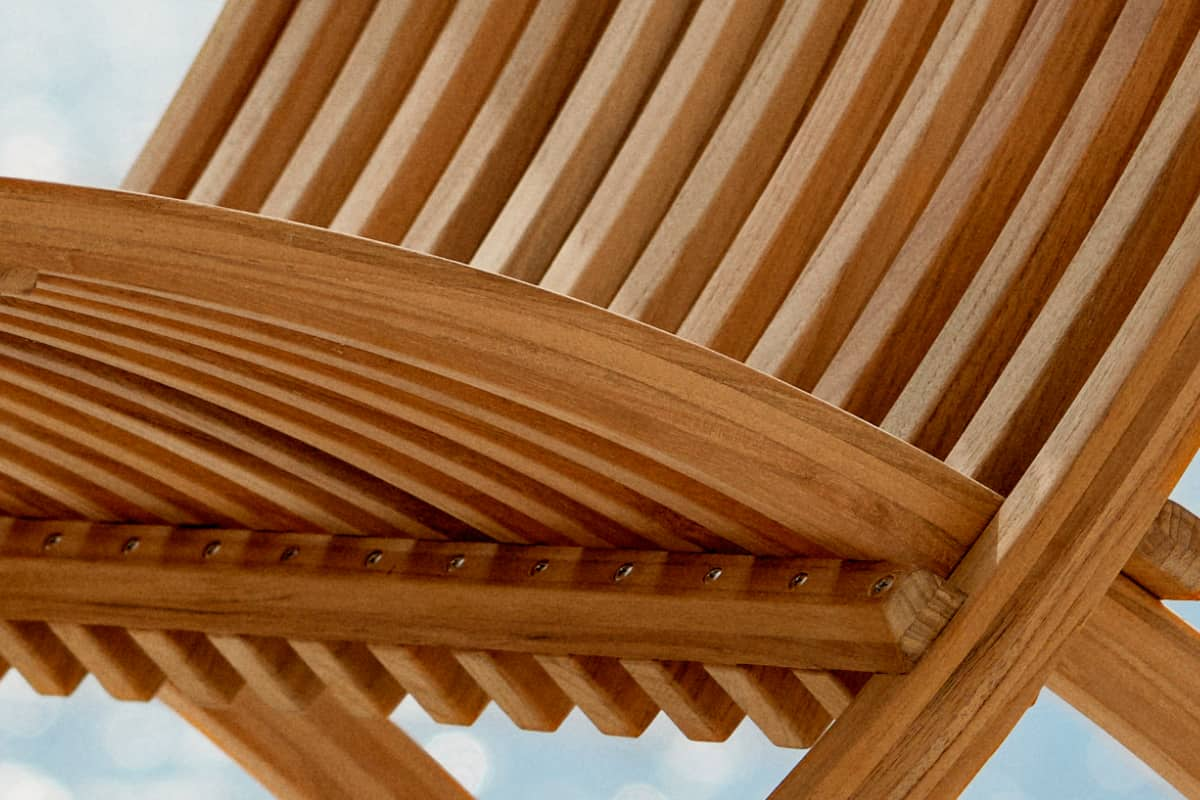
Teak
Teak is easily the most pop wood choice for outdoor piece of furniture. Its high demand, coupled with limited availability, has pushed the price of this fine-grained hardwood extremely high. Fortunately, teak has many characteristics that make it ideally suited for outdoor utilise. It is incredibly stiff and doesn't warp, crack or become brittle like many kinds of wood. This is because teak repels nearly h2o and does not expand or contract in the drying process. It has a loftier natural oil content, which makes information technology highly resistant to harm from rot, decay and insects. This immovability against the elements enables teak to last the longest – upward to fifty years! Its gorgeous honey dark-brown appearance can be maintained with minimal oiling, or it can patina into an bonny silver-gray over time, if left untreated. Well-nigh patio furniture brands accept at least a few pieces made from this handsome wood. Scandinavian manufacturers similar Skagerak and Skargaarden embrace teak's natural beauty and employ its inherent strength to pattern artistic svelte collections of outdoor lounge and dining furniture. It'southward relatively easy to care for and can be cleaned with balmy soap and h2o.
- PROS – Durable, strong, resistant to weather, decay and insects, no cracking or warping and it'southward easy to care for
- CONS – High price
Shorea
This reddish-gold Southeast Asian material is 1 of the few hardwoods that is stronger and heavier than teak. Exposure to heat actually improves its strength (modus of rupture) and flexibility (modus of elasticity) [Noh & Ahmad 2017]. Harvesting shorea (a.g.a. meranti) is highly regulated to ensure that it is sustainable, like many of the other hardwoods used for outdoor furniture. It also has a loftier oil content that protects it confronting insects, minimizes rotting and resists conditions harm. Like teak, shorea becomes a silverish-grayness patina if it is not oiled regularly and lasts up to fifty years. However, it has a much lower price. The only major drawback for shorea is that, due in function to public unfamiliarity, few retailers sell information technology.
- PROS – Strength, weather and insect resistant, eco-friendly and cost-effective versus teak
- CONS – Limited commercial availability
Eucalyptus
This stiff Australian hardwood is fast-growing, lasts a long time and offers significant price savings versus teak. Its natural washed advent has a rustic appeal, which will develop into a silver patina unless oiled regularly. Information technology is weather and rot resistant and its oil acts every bit a natural insecticide. Simply, a sealant is recommended to improve the resistance of eucalyptus to pests and minimize the negative impact of uneven moisture retentiveness.
- PROS – Durable, insect and rot-resistant, eco-friendly sustainable growth and cost-constructive
- CONS – Susceptible to marine and pinhole borers and vulnerable to cracking if untreated with a sealant
Ipe
Central and South American ipe (a.k.a. ironwood), dissimilar many of its hardwood counterparts, has a deep rich colored grain which fades slower when exposed to weathering [Jankowska, Reder, Gołofit 2017]. It has a loftier natural oil content, which helps it resist insects, decomposition and various forms of fungi. Its hard, dumbo construction fortifies information technology confronting physical damage such a denting, warping and corking. Though it can concluding up to forty years, ipe requires much preparation when cut and glued together.
- PROS – Durable, potent and resistant to pests and fungi
- CONS – Difficult to work with
White Oak
This abundant wood is stronger and harder than most and lasts for decades. Information technology has long been used to build boats, due to its structural power to repel water, which also helps it resist rot. However, it doesn't possess much natural oil and needs paint or a sealant to retain its durability. Over time, untreated white oak develops an attractive gray patina.
- PROS – Water-proof, rot-resistant and potent
- CONS – Depression oil content
Other Hardwoods
There are a number of other hardwoods that share some of the positive qualities of teak at a much lower price point. However, they likewise take drawbacks relative to the hardwoods mentioned above. Reddish-brownish acacia (a.yard.a. locust) is readily bachelor but is more probable to warp or cleft than shorea or eucalyptus. Roble is deficient, lightweight and lasts one-half as long as teak, while African iroko is very hard to piece of work with, hands splinters and blunts woodworking tools. Mahogany has a beautiful reddish tint, but is coarse, requires a lot of maintenance and doesn't handle rot besides as teak.
Metal
Metal is typically the strongest and most durable textile for outdoor garden furniture. Because of its strength, metallic frames tin can be thinner and shaped into more complex designs than other options, giving manufacturers greater fashion flexibility. Metal is as well a great pick when used in combination with other materials that have their ain functional and aesthetic benefits. Various product techniques can create metallic chairs and tables that don't crave bolts, screws or other fasteners that make other types of furniture more susceptible to break down. However, metal has its drawbacks equally well. It heats upward in the sun, making information technology uncomfortable to touch. Certain metals are very heavy and hard to movement, while all metals are vulnerable to rust and corrosion to some degree. Simply each type metal has its ain unique set of characteristics.
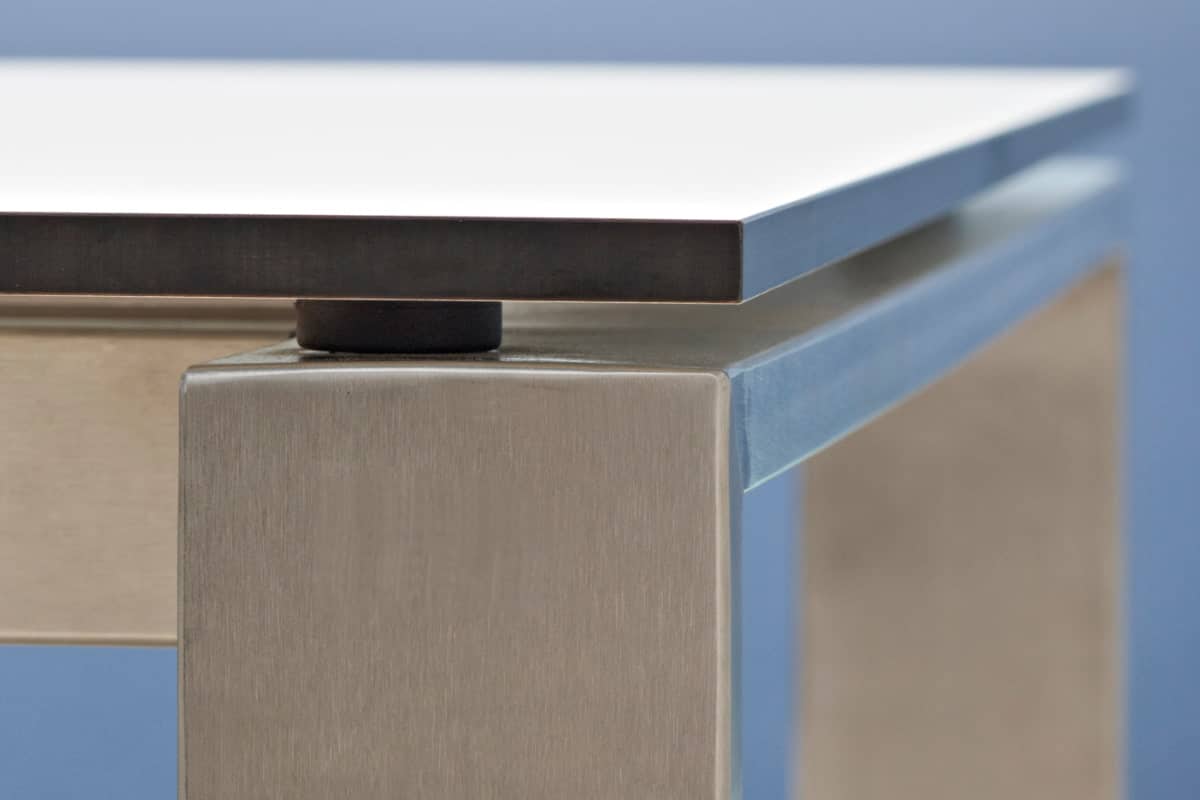
Stainless Steel
This sturdy metal alloy is extremely strong, which makes it a great material option for large weight-begetting outdoor dining tables, sofas and sectionals. Its loftier density helps forbid dents and other harm from frequent use. While information technology does go hot to the touch when exposed to the summer heat, stainless steel endures extreme temperatures better than most metals. Its composition makes information technology well-nigh immune to rust and corrosion, simply a powder coating is recommended for added resistance, especially in littoral areas where salt air and water are nowadays. If you are comparison types of stainless steel, the college the Chromium content the more resistant the alloy is to atmospheric corrosion. Similarly, the presence of Molybdenum prevents carmine rust and reduces the depth of surface pitting [Mameng, Pettersson & Leygraf 2017].
Garden and patio furniture fabricated from stainless steel is heavy and volition not tip over or blow away under windy atmospheric condition. It's a great material choice for high end modern outdoor piece of furniture since its sleek silvery metallic cease has a chic contemporary await. Though it's expensive, stainless steel is worth every penny. Not just is it relatively piece of cake to make clean, merely it's often made using recycled metals, making it an environmentally responsible choice.
- PROS – Durable, strong, resists rust, wind-resistant and like shooting fish in a barrel to make clean
- CONS – Expensive and retains estrus
Aluminum
Aluminum is the well-nigh popular metal for outdoor furniture. Despite its lightweight, information technology is strong, durable and can easily be worked into a variety of intricate shapes. Aluminum is relatively inexpensive, low maintenance and never rusts. Although information technology is highly weather-resistant on its own, a polyester powder coating is recommended. This electrostatic process not just increases protection against the elements and scratching, but it likewise allows yous to added color to the mix. While you tin buy painted aluminum, powder blanket adheres better to the metal and is much more resistant to fading. This is also helpful if your deck or poolside is exposed to salt air, which tends to eat away at paint and untreated metal. Similar other metals, aluminum heats up, and then it'due south best to accept seat cushions to keep you cool and comfy.
- PROS – Strong, lightweight, weather condition-resistant, inexpensive and low maintenance
- CONS – Hollow tube frames may blow over in high winds and it retains heat
Wrought Iron
Throughout history, iron has been used for tools, buildings and effects considering of its strength and durability – it tin terminal a hundred years if properly cared for. It's among the heaviest of metals, which makes it difficult to move wrought or bandage fe furniture. Notwithstanding, it certainly won't accident over in the wind. It is extremely malleable when heated and hammered into shape. This allows wrought atomic number 26 to form ornate hand-crafted designs with an upscale artisan feel. Cast fe, on the other mitt, is melted and poured into molds, just information technology's heavier and harder to manage than wrought iron.
While it is long-lasting, outdoor iron frames and tabletops can require a lot of care to clean, maintain and protect against rusting. Fortunately, the all-time gimmicky wrought iron is treated with weather-resistant finishes to seal out damaging moisture. Additionally, the metallic tends to lucifer the prevailing temperature – information technology gets very hot in summer and freezing common cold if left out in the winter. Wrought iron outdoor piece of furniture is hard and tin can be uncomfortable without upholstery to cushion seat and backrests.
- PROS – Durable, solid, stylish classic await and dandy for windy areas
- CONS – Rusts hands, requires more maintenance, tin be uncomfortable, difficult to motion and retains heat or cold
Resin & Plastic
Man-made synthetic materials, such as resin and plastic, are condign more and more prevalent in the earth of outdoor furniture. New manufacturing processes and hybrid compositions enable these polymers to take on shapes and sizes previously unattainable. Synthetics are typically lightweight, inexpensive and can be molded into whatsoever decor style imaginable. Because color is inherent in the chemical make-up, they are fade-resistant and don't require paint or sealants used by other materials. They're also a breeze to clean and maintain. There is a growing number of plastics and resins, but hither are a few of the more common ones currently in use.
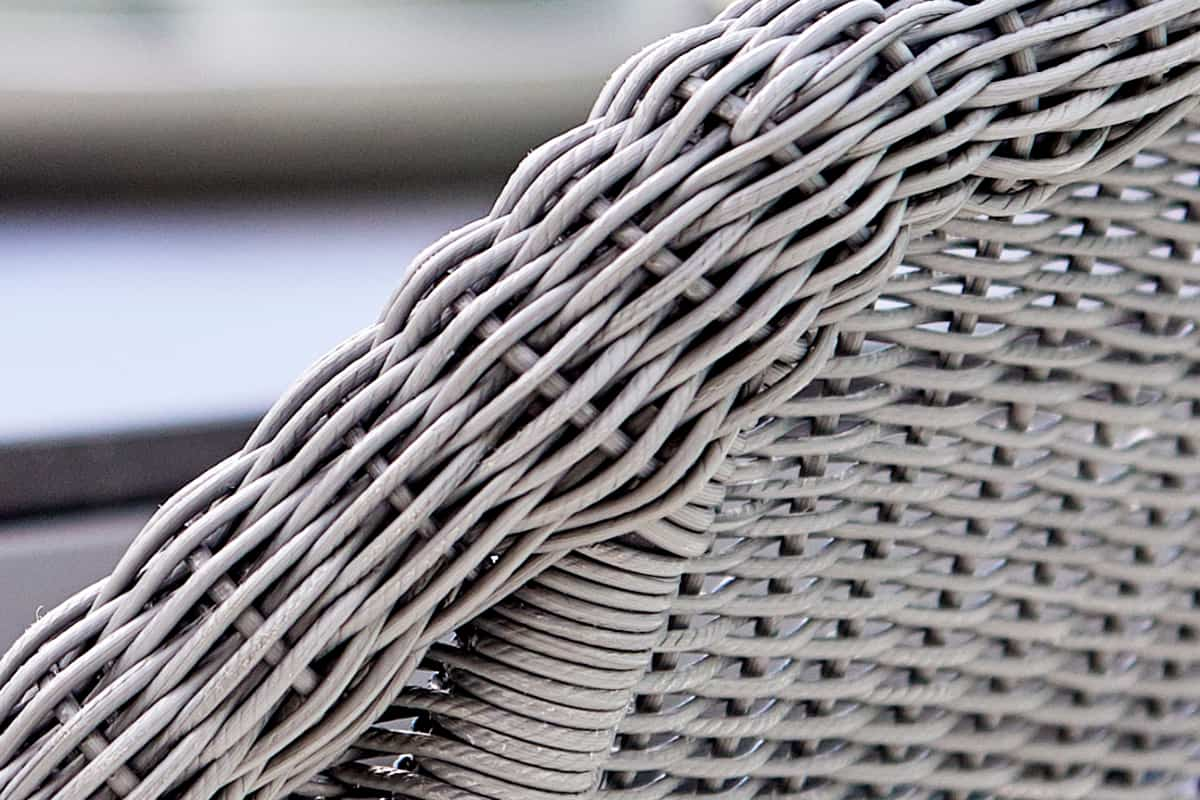
Constructed Resin – All-Weather Wicker
Most all outdoor wicker furniture is made from synthetic polyethylene resin. Natural wicker is fabricated from a diversity of organic sources such every bit rattan, seagrass, bamboo, banana foliage and even willow. While strong and aesthetically pleasing, plant-based wicker is susceptible to impairment from rainy weather condition, moisture and humidity – a poor cloth choice for outdoor chairs, sofas and java tables.
High-quality resin is very dumbo, resistant to weather impairment and eco-friendly. High-density polyethylene (HDPE) does not emit whatsoever chemicals, is highly puncture resistant and can be exposed to UV rays for decades without experiencing whatsoever deposition [Topliff 2018]. Synthetic all-conditions wicker is likewise stiff, lightweight, fade-resistant and easy to clean. There are lower quality synthetic wickers made from polyvinyl chloride (PVC), which tends to become brittle and cleft over time. Most outdoor wicker patio furniture is synthetic over an aluminum frame, which increases the weight it can support. Synthetic wicker can exist colored an organic shade, making it virtually indistinguishable from natural wicker. It tin also exist given a vibrant tone that adds a popular of color to your lanai or hardwood deck.
- PROS – Extremely weather-resistant, easy to clean, tin wait similar natural wicker and HDPE wicker is 100% recyclable
- CONS – Not heavy enough for many windy environments
Recycled Plastic
Eco-friendly recycled plastic (i.e. made from milk cartons, shampoo bottles, etc.) is a great option for fashionable outdoor patio furniture. It's extraordinarily strong, durable and resistant to moisture, mildew, insects and saltwater. It tin can be heavier than other plastic materials simply is still susceptible to high winds. Recycled plastic doesn't pare, crack or require much maintenance. It is stain-resistant and cleans easily with soap and water.
- PROS – Stiff, weather and fade resistant, piece of cake to clean and "green"
- CONS – May be also calorie-free for extremely windy atmospheric condition
Other Plastics
Polyethylene (PE) is the most common class of plastic used to brand deck furniture. It's cost-effective, only the loftier-density version (HDPE) is required for outdoor applications since information technology is far more durable and weather resistant. Polypropylene (PP) is lighter weight and highly resistant to chemical degradation and heat. Polycarbonate (PC) is a very tough material that is impact-resistant, although it is susceptible to scratching. Information technology's the preferred option of plastic when transparency is desired. Acrylic – Polymethyl Methacrylate (PMMA) is like to polycarbonate in that it is articulate. However, this less expensive alternative is not as strong and is vulnerable to cracking.
Miscellaneous Outside Piece of furniture Materials
In improver to wood, metal and plastic, luxury outdoor article of furniture utilizes a number of other durable materials in a diverseness of applications. Patio dining tables, for example, may have metallic or wooden frames with a tabletop made from another textile. These substances have different qualities that are appropriate for specific functional and aesthetic requirements.

High Force per unit area Laminate (HPL)
This composite is commonly comprised of kraft paper that is impregnated with resin and aluminum so heated under high force per unit area to create a layered contemporary material. HPL has a sleek await and is extremely difficult, helping information technology resist stains and scratches. Melamine tin exist added to increase this laminate's durability. It's flame retardant and possesses antibacterial properties. HPL made with pine kraft lignin is especially good for outdoor applications, as information technology has a low affinity for water which can cause swelling, internal stress and cracking [Ghorbani, Mahendran, van Herwijnen, Liebner & Konnerth 2017]. High-pressure laminate works well equally an elegant tabletop for modern styled outdoor dining and bistro tables, although it can be pricey relative to other material options.
- PROS – Sleek mod await, and resists bacteria and superficial marks from spills or impact
- CONS – It can cost more than alternative materials
Tempered Glass
Tempered glass is often used for outdoor tabletops, because of its resistance to temperature changes. Lacquering glass increases its protection against the effects of the elements, while acid washing inures information technology to smudges and fingerprints. Its smooth surface provides an elegant affect, while the clarity creates an open and blusterous feel. Glass is a great choice for sunroom or screened-in porch dining and coffee tables, where there is some shade to forbid the sun from reflecting off it and blinding guests. Depending on the thickness, glass can be very heavy and hard to move.
- PROS – Resists temperature and looks elegant
- CONS – Tin cause glare in sunny areas and may be likewise heavy to motion easily
Concrete
While some minimalist modern environments may incorporate solid concrete outdoor furniture into their permanent design, this composite is more oftentimes employed in conjunction with other materials. Information technology can serve as a sturdy base for glass top dining and lounge tables, or as an imposing tabletop sitting upon a substantial metal frame. Concrete is strong, timeless and tin can withstand the harshest elements for years. Information technology can be poured into a variety of shapes and, when reinforced with fiber, molded into thinner constructions. Fibers may exist comprised of drinking glass, steel, synthetic or organic material and they increase the structural integrity of the concrete. It also helps the material withstand water and frost better.
- PROS – Long-lasting, strong and can take on many shapes
- CONS – It tin be too heavy to movement quickly or hands and stains
Concrete Blended (a.k.a. polymer concrete)
In recent years, compounds take been improved in response to the growing demand for atypically shaped furniture. Designers desire the customization ability of concrete, simply lighter, stronger and more resilient to the elements. Concrete composites are a blend of Portland cement and resin or fiberglass. The resulting material has a number of advantages over traditional physical:
- Force – Some blends, such every bit Blinde Design'due south Fluid™ Physical, accept up to 8 times the tensile strength of regular concrete
- Weight – Polymer concretes are lighter than normal concrete and, because they are also stronger, less is required to perform the aforementioned role
- Porosity – Physical blended, unlike standard concrete, is non-porous so it resists stains, impact damage, scratches and smashing due to temperature changes
[Ali & Ansari 2013]
Designers can cast the material into well-nigh whatever shape with the await and feel of rock or concrete in a variety of colors. Owners benefit from furnishings made of fiber physical, because they are more portable and easier to make clean than ordinary physical versions. Additionally, concrete composite is a great option for fire tables and fire bowls that demand a sturdy non-flammable cloth that resists heating. The material may also be utilized for 3D printing.
Materials for Outdoor Article of furniture Upholstery, Slings and Pillows
Fabrics
Outdoor furniture cushions, slings and accent pillows require fabrics that can withstand the stringent demands of constant exposure to the elements. Natural fibers tend to lose vibrancy and intermission down over fourth dimension. Consequently, fabrics made from constructed thread, infused with plastic, are much better options for outdoor upholstery covers. They are more resistant to climate issues and hold their colour longer. Each constructed fabric has its ain set of benefits, drawbacks and ideal usage.
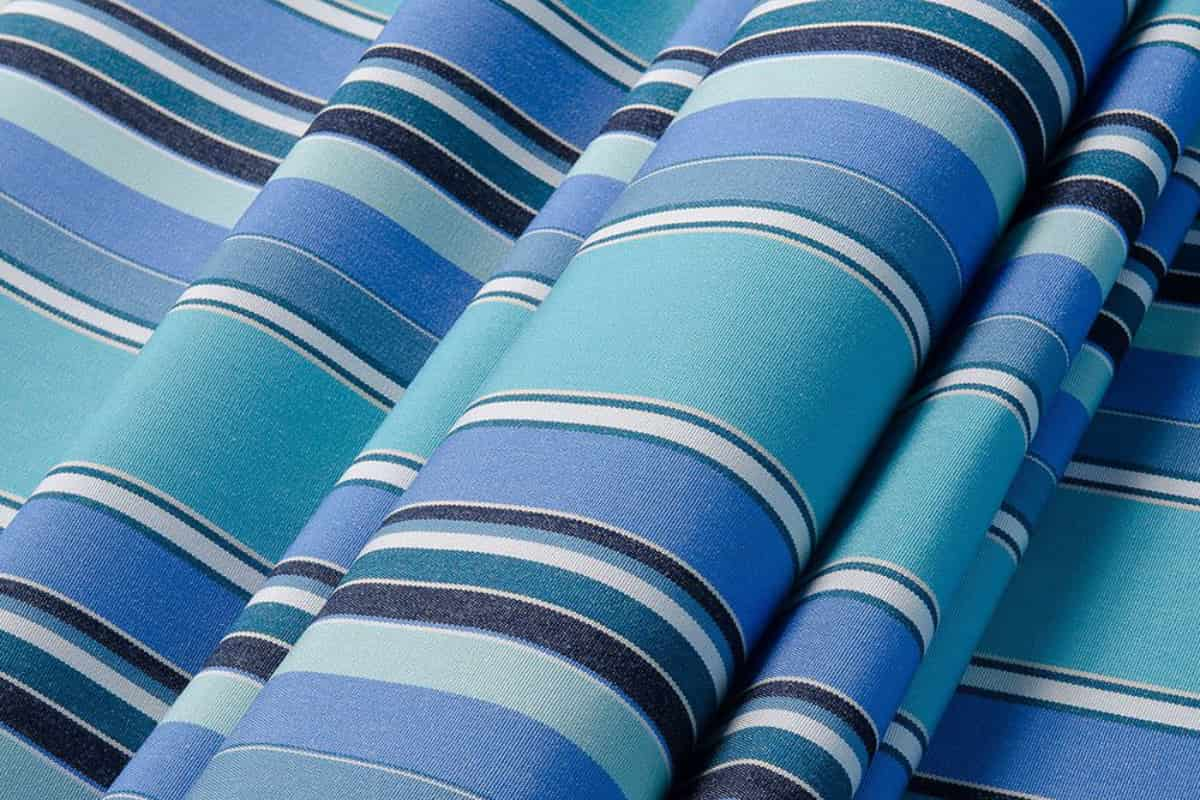
Acrylic Material
Outdoor fabrics made from acrylic fibers are potent and resistant to both weather and utilize damage. Information technology's mold and mildew resistant and tin can hold up against rubbing and tearing. This is especially of import for outdoor upholstery in active residential and commercial applications. Acrylic fabrics are solution-dyed, which means that the threads are dyed before they are woven. This allows the textile to retain its color longer, even when exposed to direct sunlight. While it is water-resistant, acrylic textile is more breathable than other options, allowing information technology to stay cooler in hot weather. It's besides easy to clean with balmy lather and h2o. All things considered, acrylic fabric is best all-purpose cloth for outdoor piece of furniture cushions, throw pillows and patio umbrellas.
Sunbrella®
Sunbrella® is generally recognized every bit the "golden standard" of acrylic outdoor textiles. The company has products that range from soft and suitable for urban home use up to marine form materials that can survive the rigors of saltwater, wind and sun on yachts and catamarans. You get what you pay for, and premium acrylic fabrics have a much higher price tag than other materials.
- PROS – Stiff, durable, weather and moisture resistant, doesn't fade and is easy to clean
- CONS – High cost
Olefin Material
Olefin is some other solution-dyed synthetic fabric that is durable, quick-drying and fade-resistant. Information technology stands upward to mold, moisture and heat and is less expensive than acrylics. Olefin is lightweight and smooth, but it tin can lack the softness of some other textiles. Information technology resists stains and abrasions and is easy to clean. It'south a groovy selection when acrylics are outside of your upkeep.
Etisilk – Texsilk®
Etisilk's Texsilk® is one of the amend-known brands of olefin outdoor garden and pool piece of furniture fabric. It'due south stain-resistant and strong plenty to be cleaned by bleach or chlorine. Texsilk® is environmentally responsible and certified as a safety fabric by OEKO-TEX.
- PROS – Durable, quick-drying, fade-resistant, easy maintenance and affordable
- CONS – Not equally soft equally culling materials
Polyester Fabric
This synthetic cloth is typically coated with either an acrylic or vinyl (PVC mesh) to protect it from the elements. Polyester is stiff, flexible and resists h2o damage and staining. It's tear-resistant and dries chop-chop, simply most outdoor polyester fabrics (at least the non-treated boilerplate grade options) fade faster than other synthetic textiles. Unlike, solution-dyed alternatives, polyester hybrids are dipped in color or have the colour painted on after the threads are woven. You can reach brighter colors and more intricate patterns, simply it won't concluding equally long when exposed to UV rays. Consequently, they practice much better in shaded environments, when there is less direct sunlight.
Acrylic coated polyester works well for accents and pillows, while vinyl-coated polyester has a plastic-like experience that is meliorate suited for self-supporting seat and dorsum slings, screens, umbrellas and backing, where there is less peel contact. Two of the most renowned manufacturers of high-end PVC-coated polyester textiles are Ferrari and Twitchell.
Ferrari – Batyline® Mesh
Batyline® mesh is a premium synthetic outdoor material that is extremely strong and tear-resistant. Its open design allows airflow that helps the textile stay cool and dry out quickly. It is an ideal choice for self-supporting sling seating similar poolside sunloungers, patio dining chairs and bar stools.
Twitchell – Textilene® Mesh
Textilene® mesh is similar to Batyline® in its applications. It'south used by many luxury outdoor furniture brands like Sifas for the seat and dorsum slings of high-end lounge chairs and sofas. Twitchell besides manufactures a diversity of mesh grades that are advisable for sun screens, awnings, tarps and fencing.
- PROS – Strong, resists tearing and water damage, quick drying and comes in assuming colors and patterns
- CONS – Tends to fade fast than other fabrics
Core Cream
Cushions and accent pillows for outdoor furniture are only every bit adept every bit the materials that go into them. At some bespeak, they're going to be exposed to rain, sleet, moisture bathing suits or damp beach towels. Fifty-fifty if they accept the most weather condition-resistant premium acrylic cover, some water volition find its way in through seams and zippered closures. Consequently, the foam cadre of your upholstery must not but hold its shape and comfort level, only it must also be able to dry quickly and prevent impairment from moisture too. Foam varies in quality, based on the material, production technique and treatment.
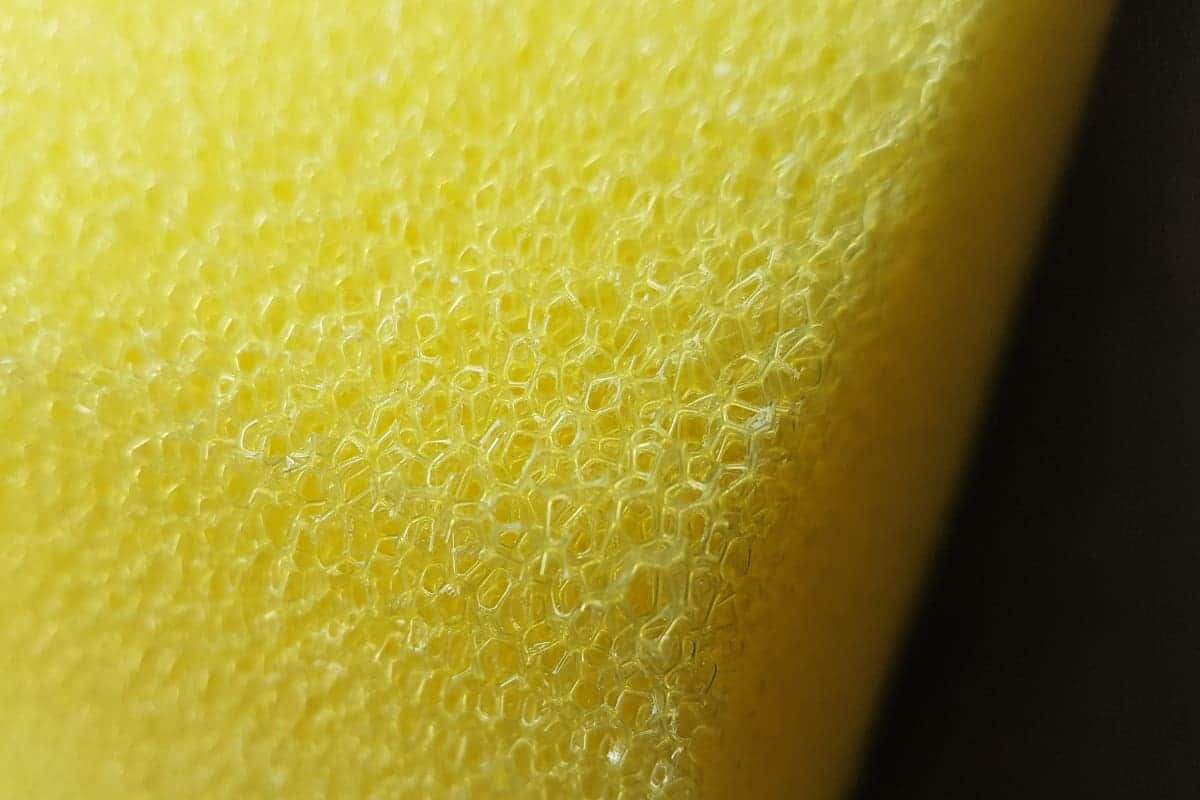
Open Cell Foam
Open-cell foam has pores that allow water and air to easily menstruation through it. It's comfortable and cool, just more than expensive than about alternatives. It is synthetic with an antimicrobial agent that protects the foam from mold and mildew growth that tin occur in the drying process.
Urecel – QuickDry® Foam
Urecel'south QuickDry® is the premium brand of open-prison cell foam. Information technology is an avant-garde, high-performance foam that is specifically engineered for outdoor upholstery. QuickDry® is produced using a sophisticated process known every bit Hydro-Blast Reticulation, which makes the foam durable, strong and extremely comfortable. Information technology also incorporates Uregard anti-microbial technology to go along it free from biological problems. QuickDry® is used by luxury outdoor furniture brands like Mamagreen and Cane-line.
- PROS – Quick-drying, comfortable and resists mold and mildew
- CONS – Expensive
Closed Cell Foam
Closed-cell foam (a.thou.a. floatation cream) repels water and is buoyant, making it a skilful choice for boat seating and life vests. It can be made from a diverseness of plastics including neoprene, polypropylene, polyethylene and polystyrene. Each version has its own unique characteristics and applications. Spongy neoprene, for example, is flexible and provides thermal and moisture insulation for moisture suits.
- PROS – Repels water, floats and variations have benefits for specific applications
- CONS – Expensive
Polyethylene Terephthalate (PET) Foam
PET foam inserts are durable, recyclable and provide optimum support for outdoor upholstery. They are firm and practice not flatten out or lose their shape like some materials. PET dries apace, preventing wet build up that can lead to mildew and mold.
Dacron®
Dacron® is a leading brand of hypo-allergenic PET foam and information technology is often wrapped around other foams to provide an additional layer of protection.
- PROS – Durable, supportive, eco-friendly, quick-drying and resistant to mold and mildew
- CONS – Premium brands can exist costly
Polyurethane Foam
This common affordable seating foam has a medium firmness and will soak upwardly h2o if it gets wet. Nigh polyurethane foam is treated with a biocide that prevents mucus, mold and mildew from growing as the wet cream dries out. It'south ofttimes wrapped in plastic for extra protection before beingness inserted into an outdoor encompass.
- PROS – Depression price and resistant to biological issues
- CONS – Soaks up water, dries slowly and is more flammable
Polyester Cream
Compressed polyester is an cheap alternative to traditional foam. It dries relatively quickly and is easy to wash. It works best in depression to moderate employ outdoor environments, since information technology compresses over fourth dimension and frequent employ volition cause it to lose shape quicker. Polyester fiberfill is another low-price option that is machine washable and resistant to mildew. It is normally stuffed into an inner pre-sewn encompass that is and then covered in outdoor fabric. I drawback is that the loose fibers tend to bunch up during laundering and may demand reshaping later heavy use.
- PROS – Cheap, dries relatively quickly and is easy to launder
- CONS – Loses its shape and usually require additional protective wrapping
Outdoor Furniture Materials Cheatsheet
To view a printable cheatsheet summary of many of the materials higher up, click here.
How do you make clean and treat patio piece of furniture?
The usable life of your outdoor piece of furniture tin exist extended past keeping it clean and well-cared for during and after the Summer months. Each textile has specific instructions for cleaning various types of spills, repairing damage and protecting information technology from the ravages of the wind, rain and sun. Read our Patio Furniture Cleaning & Care Guide for a detailed look at a variety of materials and tips for maintaining them.
References
- Ghorbani, K., Mahendran, A. R., van Herwijnen, H. W., Liebner, F., & Konnerth, J. (2018). Based laminates produced with kraft lignin-rich phenol–formaldehyde resoles meet requirements for outdoor usage. European Journal of Forest and Wood Products, 76(two), 481-487.
- Jankowska, A., Reder, M., & Gołofit, T. (2017). COMPARATIVE Report OF WOOD Color STABILITY USING ACCELERATED WEATHERING PROCESS AND INFRARED SPECTROSCOPY. WOOD Inquiry, 62(four), 549-556.
- Mameng, S. H., Pettersson, R., & Leygraf, C. (2017). Issue of Stainless Steel Composition on Atmospheric Corrosion Resistance at a Marine Site in Dubai. Corrosion, 73(7), 880-891.
- Noh, N. I. F. Yard., & Ahmad, Z. (2017, November). Heat treatment on keruing and low-cal cerise meranti: The outcome of estrus exposure at different levels of temperature on bending force backdrop. In IOP Conference Series: Materials Science and Engineering (Vol. 271, No. 1, p. 012060). IOP Publishing.
- Topliff, C. R. (2018). USES AND INSTALLATION OF HDPE LINER TO REDUCE SOIL EROSION AND PREVENT WATER LOSS (Doctoral dissertation).
- Ali, A., & Ansari, A. A. (2013, April). Polymer Concrete as Innovative Material for Development of Sustainable Compages. In 2nd International Conference on Emerging Trends in Engineering & Technology. College of Applied science, Teerthanker Mahaveer University (pp. one-4).
What blazon of outdoor furniture is the most durable?
The best material for patio article of furniture depends on the climate in which you alive.
1) Aluminum - Powder-coated versions will do well in all environments, merely may exist a fleck lightweight for extremely windy conditions (bandage or wrought aluminum improve)
2) Teak & Other Hardwoods - If properly sealed and periodically treated, these sturdy woods will final a long time and develop a prissy patina simply some hardwoods may warp or crevice if not protected
3) Resin Wicker - HDPE wicker is extremely strong and will resist impairment from moisture, high temperature and UV rays, although information technology may accident away if not weighted downwardly in high wind locations
4) Stainless Steel - Its high-density, weight and strength make this metal keen for outdoor tables in most climates and it resists corrosion the higher the chromium content or if powder-coated, although it does go hot in the dominicus
v) Wrought Iron - This extremely heavy fabric tin can last a century if properly cared for, simply it does require a lot of TLC to clean and protect from rusting
How long does wicker furniture concluding?
Traditional natural wicker made from rattan, bamboo or seagrass is strong just does non fare well outdoors. It's susceptible to warping, mold and mildew from rain and humidity. In drier climates, it may become brittle and cleft.
Almost all wicker used for patio article of furniture is now woven from polyethylene resin. This synthetic wicker is extremely dense, strong and weather-resistant. Additionally, it does not fade speedily and so your outdoor seating and tables will terminal a long fourth dimension. Loftier-density polyethylene (HDPE) is the virtually durable resin wicker, while lower quality PVC wicker will degrade over a shorter menses of fourth dimension. The one thing to be careful about with synthetic wicker is that information technology is lightweight and may exist damaged in windy conditions depending on the woven design.
Why is Sunbrella material so skilful outdoors?
Sunbrella® acrylic outdoor textiles are considered the premium for patio umbrellas, upholstery, awnings and other shade structures. The solution-dyed material is strong and resists both weather impairment and fading for years. It'south also easy to launder and is resistant to mold and mildew. Sunbrella® is expensive, merely because it's longlasting yous don't have to continually supersede canopies and absorber covers - saving you money in the long run. Sunbrella® produces a wide range of textile grades for full general residential to high-use commercial and even marine applications. If you have a large invest in patio furniture and value UV protection, it makes sense to go with the best.
Source: https://decoroutdoor.com/blog/outdoor-furniture-materials-guide/
0 Response to "Wicker Patio Table Glass Top Wicker Patio Table Glass Top Art Van"
Enregistrer un commentaire